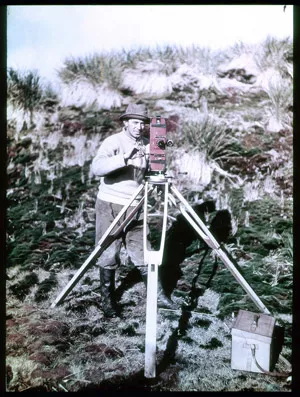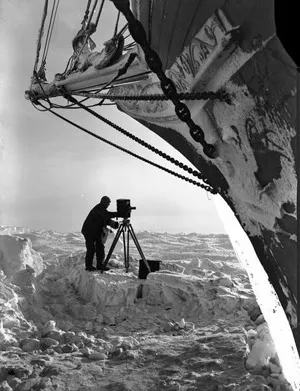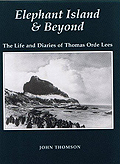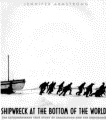James Francis (Frank) Hurley (1885-1962)
Biographical
notes
Photographer
Australasian
Antarctic Expedition - 1911-13
Photographer
Endurance
- 1914-17 - 29 at the start of the expedition.
Single, was of Sydney, New South
Wales. He had been the recipient of many amateur and professional
awards for photographic work before joining the Expedition.
At the Main Base he obtained excellent photographic and cinematographic
records and was one of the three members of the Southern Sledging
Party. He was also present on the final cruise of the `Aurora'.From Appendix 1, Mawson - Heart of the Antarctic.
The
Endurance Expedition
The only member of Shackleton's expedition that Shackleton didn't meet or interview before the expedition set off, Hurley was accepted on the the strength of his work with Mawson on the 1911-13 Australasian Antarctic Expedition.
Hurley joined Shackleton's Endurance expedition at six weeks notice meeting the ship in Buenos Aires after travelling from Australia. He had been warned by Mawson to make an arrangement with Shackleton whereby he was paid a percentage of the profits of the expedition. It was in Shackleton's financial interests to make sure that a full pictorial record of the expedition made it back home.
Hurley was tall and tough, his first impressions of the crew of the Endurance were not favourable thinking that their physiques were small and not up to standard of the men on Mawson's Australian Antarctic Expedition.
Nonetheless, he was as Greenstreet put it "a warrior with his camera & would go anywhere or do anything to get a picture". At that time a camera was a large wooden boxed structure weighing many pounds and requiring more wooden boxes of glass plates that were used to take the negatives. Even taking the simplest photograph was a significant undertaking and Hurley regularly hauled his equipment, 40 lbs of it and more to difficult places, to the top of the Endurance's masts or up peaks in South Georgia for instance.
He was also a skilled tinsmith and made a water pump for the lifeboats and also a portable stove taken around from camp to camp from materials salvaged from the Endurance, both difficult jobs due to the lack of correct and sharp tools for the jobs.
Even though many photographic plates taken on the Endurance expedition were destroyed before taking to the lifeboats, many survived along with a good deal of cine film which provide the pictorial record of the story. Hurley rescued many of the plates after the Endurance had been lost, but still not fully submerged by returning to the wreck and bare-chested to the waist dived into 3 feet of mushy ice and sea-water to retrieve cases of glass negative plates that were protected by being zinc lined and soldered shut.
Hurley sat with Shackleton on the ice at Shackleton's insistence and they decided between them which plates to keep and which to leave to conserve weight. Those to be left were broken so second thoughts were not an option. 150 of the best plates were saved and the remainder, about 400 were destroyed.
Hurley was nicknamed "The Prince" on the expedition for his susceptibility to flattery, a trait which Shackleton had reason to use as a means to keeping Hurley onside during the most difficult times and to temper Hurley's sometimes overly forthright and uninhibited manner.
He continued to be critical about his fellow crew members on arrival at Elephant Island, recording in his diary that
"... many conducted themselves
in a manner unworthy of Gentleman and British sailors. Some
of whom it was anticipated would be the bulwarks of the
party "stove in". In the majority of cases those suffering
from severe frostbites could be traced to negligence..."
"Amongst those that stand meritorious, Sir E. has mentioned:
Wild - a tower of strength who appeared as well as ever
after 32 hours at the tiller in frozen clothes, Crean who
... piloted the Wills, McNiesh (Carpenter) Vincent (AB)
McCarthy (AB) Marston (Dudley Docker) & self"
Note that he included himself without comment. He went on to say that:
"A fair proportion of the remainder. I am convinced would starve or freeze if left to their own resources on this island"
Hurley had total admiration for Shackleton's leadership under these circumstances with what he saw was less than ideal material.
After the rescue and return home of the expedition members, Hurley returned to South Georgia, to shoot more footage for his film of the expedition. He attempted to follow in the footsteps of Shackleton, Crean and Worsley across the island, but despite it being summer and having proper equipment, he found it impossible to do so.
It is largely due to Hurley's pictures that we are able to get such a good impression of the events and that the Endurance story is still very alive and capturing people's imaginations even today.
Biography
Hurley left school and home at the age of 13, without any qualifications and worked in a steel mill and the Sydney dockyards. Eventually he studied at the University of Sydney and taught himself photography.He was the official photographer on Douglas Mawson's 1911-1914 Australasian Antarctic Expedition and also on Ernest Shackleton's 1914-1917 British Trans-Antarctica Expedition, he spent over four years in Antratica.
After the Endurance expedition, Hurley served as an army photographer in the First World War.
Later he became the official photographer to a number of expeditions to tropical regions, returning to the Antarctic again in 1929-1931 on the BANZARE voyage (British, Australian and New Zealand Antarctic Research Expedition).
He was a war photographer again in World War Two.
Frank Hurley died aged 76 on the 17th of January 1962 in Sydney.
References to Frank Hurley by Orde-Lees in "Elephant Island and Beyond" buy USA buy UK
-
The training of dogs has commenced - soon their services will relieve us of a great deal of not unpleasant work in bringing in distant seals. Wild, Marston, Crean, Macklin, McIlroy and Hurley are the dog men: none of them has any preliminary experience to speak of, but this does not seem at all essential.
-
I have just found myself unwittingly drawn into a little misunderstanding with Hurley our capable photographer. Since the dogs have been on board it has been necessary to supply them with drinking water. When on the floe, they used to quench their thirst for themselves by eating snow. The drinking water is now drawn by the dog drivers, of whom Hurley is one, from the ice-melter in the ward room, and as I have to keep the supply of ice for the latter it necessitates me bringing down a much increased quantity of ice (I had as much as I could do previously).
I therefore petitioned Sir Ernest that the dog drivers should bring down a daily amount of ice equivalent roughly to the quantity of water they used. Sir Ernest acquiesced and gave verbal orders to that effect, whereupon Hurly turned on me and characterised me as a "**** of the first water".
I suggested that he should try to control himself a little. This mild report merely added fuel to the fire and as I observed that this resentment increased very noticeably during the last few days, I deemed it best to swallow my pride and, seizing a quiet moment, informed Hurley that down here there was no room for individual quarrels, and that I bore him no malice and so on.
He seemed a little taken aback but after a little demur grasped the reasonableness of my mission and we were at peace once more. My action may imply weakness to those who cannot construe it otherwise, but I am satisfied of the fitness of it, and what else matters? Fights between men living continually in each others company have little to recommend them. -
Hurley is an interesting character. He is Australian - very Australian - and was photographer on Sir Douglas Mawson's recent Australasian Antarctic Expedition to Adelie Land. As a photographer he excels and I doubt if his work could be equaled, even by Ponting, but it is not only as a photographer but as a general handy man that he has proved his efficiency. Having started life in some engineering firm, he is an extraordinarily able mechanic, especially at tin smithing and brass work. He is generally ready to lend a helping hand and he is invaluable as a general repairer. The ingenious ice-melter and other devices that he has constructed for us are tokens to his manipulative skill. He runs our little electric light plant admirably, having at one time been an electrician in the Sydney Post Office. He is certainly one of our hardest workers and the more difficult the job the more he seems o revel in it. Unfortunately he is rather too free with his tongue to be an ideal companion, and a little inclined to let his prejudices run riot, but apart from this he is quite a good chap and of his intrinsic merit there cannot possibly be two opinions. His interest in the expedition, on his own admission, is mainly a commercial one so it is sometimes a case of "one for you and two for me", but he never really lets this stand in the way of his zeal for the general efficiency of the expedition. Occasionally he gets on one's nerves rather, banging doors and talking loudly to anyone who may be about when he is on night watch. In fact I don't reckon to get much sleep when he is on watch.
-
Hurley too is continually devising new and useful appliances and is at present occupied in constructing a very presentable bilge pump for the whaler out of the brass case belonging to the binnacle compass and which usually holds the iron steadying bar, by which the compass is steadied in some way, I believe.
-
The most valuable things we have from a financial point of view are the photos and cinematograph films. These are carefully guarded by Hurley who is, so he says to get 25 percent out of the takings of them, and should therefore make a small fortune out of them.
References to Frank Hurley in Shackleton's book "South!" buy USA buy UK
- Seals were plentiful. We saw large numbers on the
pack and several on low parts of the barrier, where
the slope was easy. The ship passed through large schools
of seals swimming from the barrier to the pack off shore.
The animals were splashing and blowing around the Endurance,
and Hurley made a record of this unusual
sight with the kinematograph-camera.
- On the following day Wild, Hurley,
Macklin, and McIlroy took their teams to the Stained
Berg, about seven miles west of the ship, and on their
way back got a female crab-eater, which they killed,
skinned, and left to be picked up later. They ascended
to the top of the berg, which lay in about lat. 69°
30' S., long. 51° W., and from an elevation of 110
ft. could see no land. Samples of the discoloured ice
from the berg proved to contain dust with black gritty
particles or sand-grains.
- If the ship had heeled any farther it would have
been necessary to release the lee boats and pull them
clear, and Worsley was watching to give the alarm.
Hurley meanwhile descended to the floe
and took some photographs of the ship in her unusual
position.
- Morning came in chill and cheerless. All hands were
stiff and weary after their first disturbed night on
the floe. Just at daybreak I went over to the Endurance
with Wild and Hurley, in order to retrieve
some tins of petrol that could be used to boil up milk
for the rest of the men.
- On December 20, after discussing the question with
Wild, I informed all hands that I intended to try and
make a march to the west to reduce the distance between
us and Paulet Island. A buzz of pleasurable anticipation
went round the camp, and every one was anxious to get
on the move. So the next day I set off with Wild, Crean,
and Hurley, with dog teams, to the
westward to survey the route.
- Hurley meanwhile had rigged his
kinematograph-camera and was getting pictures of the
Endurance in her death-throes. While he was engaged
thus, the ice, driving against the standing rigging
and the fore-, main- and mizzen-masts, snapped the shrouds.
The foretop and topgallant-mast came down with a run
and hung in wreckage on the fore-mast, with the fore-yard
vertical. The main-mast followed immediately, snapping
off about 10 ft. above the main deck. The crow's-nest
fell within 10 ft. of where Hurley stood turning the
handle of his camera, but he did not stop the machine,
and so secured a unique, though sad, picture.
- A path over the shattered floes would be hard to
find, and to get the boats into a position of peril
might be disastrous. Rickenson and Worsley started back
for Dump Camp at 7 a.m. to get some wood and blubber
for the fire, and an hour later we had hoosh, with one
biscuit each. At 10 a.m. Hurley and
Hudson left for the old camp in order to bring some
additional dog-pemmican, since there were no seals to
be found near us.
Landmarks named after James Hurley
Feature Name: Cape
Hurley
Feature Type: cape
Latitude:
6736S
Longitude: 14518E
Description: An ice-covered coastal
point marking on the east the mouth of the
depression
occupied by the Mertz Glacier. Discovered by the AAE (1911-14)
under Douglas Mawson.
Feature Name: Mount
Hurley
Feature Type: summit
Latitude: 6617S
Longitude:
05121E
Description: Snow-covered
massif with steep bare slopes on the W side, standing 7
mi S of Cape Ann
and 3 mi S of Mount Biscoe. Discovered
in January 1930 by the BANZARE, 1929-31, under Mawson.
Other Crew of the Endurance Expedition
Bakewell,
William - Able Seaman
Blackborow,
Percy - Stowaway (later steward)
Cheetham,
Alfred - Third Officer
Clark, Robert S.
- Biologist
Crean, Thomas
- Second Officer
Green, Charles J.
- Cook
Greenstreet,
Lionel - First Officer
Holness, Ernest
- Fireman/stoker
How, Walter E.
- Able Seaman
Hudson, Hubert T.
- Navigator
Hurley, James Francis
(Frank) - Official Photographer
Hussey,
Leonard D. A. - Meteorologist
James,
Reginald W. - Physicist
Kerr, A. J.
- Second Engineer
Macklin,
Dr. Alexander H. - Surgeon
Marston, George
E. - Official Artist
McCarthy, Timothy
- Able Seaman
McIlroy, Dr. James
A. - Surgeon
McLeod, Thomas
- Able Seaman
McNish, Henry
- Carpenter
Orde-Lees, Thomas
- Motor Expert and Storekeeper
Rickinson, Lewis
- First Engineer
Shackleton,
Ernest H. - Expedition Leader
Stephenson,
William - Fireman/stoker
Vincent, John
- Able Seaman
Wild, Frank
- Second in Command
Wordie, James M.
- Geologist
Worsley, Frank
- Captain
Biographical information
- I am concentrating on the Polar experiences of the men involved.
Any further information or pictures visitors may have will be gratefully received.
Please email
- Paul Ward, webmaster.
What are the chances that my ancestor was an unsung part of the Heroic Age
of Antarctic Exploration?
Ernest Shackleton Books and Video

South - Ernest Shackleton and the Endurance Expedition (1919)
original footage - Video

Shackleton
dramatization
Kenneth Branagh (2002) - Video

Shackleton's Antarctic Adventure (2001)
IMAX dramatization - Video

The Endurance - Shackleton's Legendary Expedition (2000)
PBS NOVA, dramatization with original footage - Video
Endurance : Shackleton's Incredible Voyage
Alfred Lansing (Preface) - Book

South with Endurance: Frank Hurley - official photographer
Book
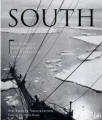
South! Ernest Shackleton Shackleton's own words
Book

Shackleton's Way: Leadership Lessons from the Great Antarctic Explorer
Book

